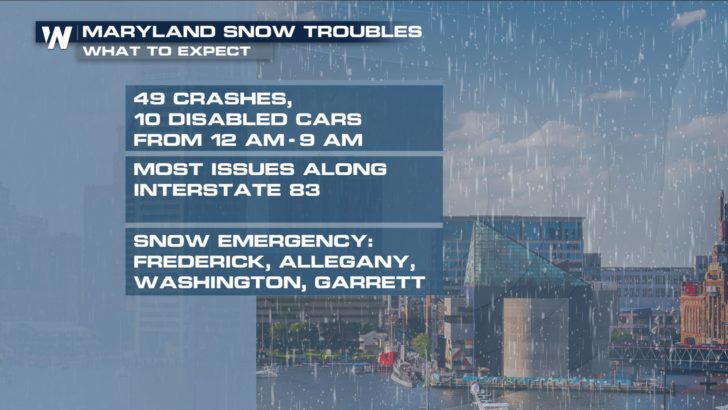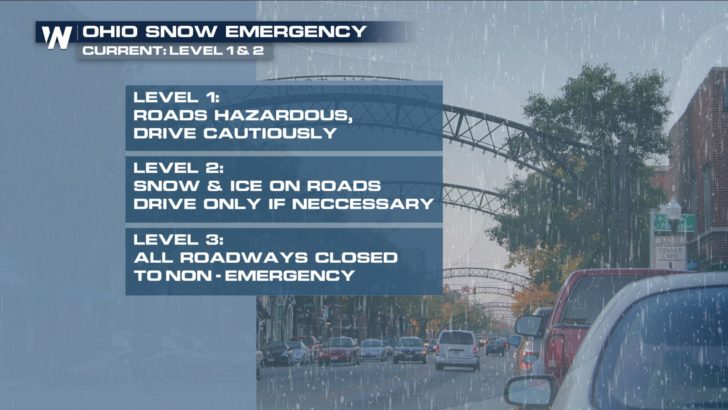Winter Storm Prompts Snow Emergencies
Special Stories
7 Feb 2018 9:41 AM
Freezing rain, ice, and snow have impacted communities from the Ozarks to the Ohio Valley and into the Northeast. Some locations have fared worse than others. Reports of more than one-quarter inch of ice have been observed in parts of Ohio, Pennsylvania, and Maryland. Several inches of snow have wreaked havoc on area roadways as well. Cities and counties have begun to issue Snow Emergencies.
 The definition of a Snow Emergency varies from state to state. In Ohio, for example, the sheriff of a county may declare a snow emergency and temporarily close county and township roads within their jurisdiction for the preservation of the public peace. Ohio Attorney General Opinion 97-015 allows the sheriff to close state and municipal roads.
There are three Snow Emergency levels in Ohio:
The definition of a Snow Emergency varies from state to state. In Ohio, for example, the sheriff of a county may declare a snow emergency and temporarily close county and township roads within their jurisdiction for the preservation of the public peace. Ohio Attorney General Opinion 97-015 allows the sheriff to close state and municipal roads.
There are three Snow Emergency levels in Ohio:
 LEVEL 1: Roadways are hazardous with blowing and drifting snow. Roads may also be icy. Motorists are urged to drive very cautiously.
LEVEL 2: Roadways are hazardous with blowing and drifting snow. Roads may also be very icy. Only those who feel it is necessary to drive should be out on the roads. Contact your employer to see if you should report to work. Motorists should use extreme caution.
LEVEL 3: All roadways are closed to non-emergency personnel. No one should be driving during these conditions unless it is absolutely necessary to travel or a personal emergency exists. All employees should contact their employer to see if they should report to work. Those traveling on the roads may subject themselves to arrest.
As of late Wednesday morning, Franklin County (Columbus, Ohio) was under a Level 2 Snow Emergency.
https://twitter.com/10TV/status/961193390024151040
As this storm ramps up in New England, several cities have already issued Snow Emergency declarations. This includes Nashua, New Hampshire, where street parking has been banned.
https://twitter.com/nashuadpw/status/960998377503756288
Be sure to keep it tuned to WeatherNation's FACEBOOK and TWITTER accounts to the latest winter storm information.
-Meteorologist Joe Astolfi
LEVEL 1: Roadways are hazardous with blowing and drifting snow. Roads may also be icy. Motorists are urged to drive very cautiously.
LEVEL 2: Roadways are hazardous with blowing and drifting snow. Roads may also be very icy. Only those who feel it is necessary to drive should be out on the roads. Contact your employer to see if you should report to work. Motorists should use extreme caution.
LEVEL 3: All roadways are closed to non-emergency personnel. No one should be driving during these conditions unless it is absolutely necessary to travel or a personal emergency exists. All employees should contact their employer to see if they should report to work. Those traveling on the roads may subject themselves to arrest.
As of late Wednesday morning, Franklin County (Columbus, Ohio) was under a Level 2 Snow Emergency.
https://twitter.com/10TV/status/961193390024151040
As this storm ramps up in New England, several cities have already issued Snow Emergency declarations. This includes Nashua, New Hampshire, where street parking has been banned.
https://twitter.com/nashuadpw/status/960998377503756288
Be sure to keep it tuned to WeatherNation's FACEBOOK and TWITTER accounts to the latest winter storm information.
-Meteorologist Joe Astolfi
 The definition of a Snow Emergency varies from state to state. In Ohio, for example, the sheriff of a county may declare a snow emergency and temporarily close county and township roads within their jurisdiction for the preservation of the public peace. Ohio Attorney General Opinion 97-015 allows the sheriff to close state and municipal roads.
There are three Snow Emergency levels in Ohio:
The definition of a Snow Emergency varies from state to state. In Ohio, for example, the sheriff of a county may declare a snow emergency and temporarily close county and township roads within their jurisdiction for the preservation of the public peace. Ohio Attorney General Opinion 97-015 allows the sheriff to close state and municipal roads.
There are three Snow Emergency levels in Ohio:
 LEVEL 1: Roadways are hazardous with blowing and drifting snow. Roads may also be icy. Motorists are urged to drive very cautiously.
LEVEL 2: Roadways are hazardous with blowing and drifting snow. Roads may also be very icy. Only those who feel it is necessary to drive should be out on the roads. Contact your employer to see if you should report to work. Motorists should use extreme caution.
LEVEL 3: All roadways are closed to non-emergency personnel. No one should be driving during these conditions unless it is absolutely necessary to travel or a personal emergency exists. All employees should contact their employer to see if they should report to work. Those traveling on the roads may subject themselves to arrest.
As of late Wednesday morning, Franklin County (Columbus, Ohio) was under a Level 2 Snow Emergency.
https://twitter.com/10TV/status/961193390024151040
As this storm ramps up in New England, several cities have already issued Snow Emergency declarations. This includes Nashua, New Hampshire, where street parking has been banned.
https://twitter.com/nashuadpw/status/960998377503756288
Be sure to keep it tuned to WeatherNation's FACEBOOK and TWITTER accounts to the latest winter storm information.
-Meteorologist Joe Astolfi
LEVEL 1: Roadways are hazardous with blowing and drifting snow. Roads may also be icy. Motorists are urged to drive very cautiously.
LEVEL 2: Roadways are hazardous with blowing and drifting snow. Roads may also be very icy. Only those who feel it is necessary to drive should be out on the roads. Contact your employer to see if you should report to work. Motorists should use extreme caution.
LEVEL 3: All roadways are closed to non-emergency personnel. No one should be driving during these conditions unless it is absolutely necessary to travel or a personal emergency exists. All employees should contact their employer to see if they should report to work. Those traveling on the roads may subject themselves to arrest.
As of late Wednesday morning, Franklin County (Columbus, Ohio) was under a Level 2 Snow Emergency.
https://twitter.com/10TV/status/961193390024151040
As this storm ramps up in New England, several cities have already issued Snow Emergency declarations. This includes Nashua, New Hampshire, where street parking has been banned.
https://twitter.com/nashuadpw/status/960998377503756288
Be sure to keep it tuned to WeatherNation's FACEBOOK and TWITTER accounts to the latest winter storm information.
-Meteorologist Joe AstolfiAll Weather News
More